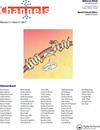瘦素介导的离子通道调节:PI3K通路、生理作用和治疗潜力
IF 3.2
3区 生物学
Q2 BIOCHEMISTRY & MOLECULAR BIOLOGY
引用次数: 29
摘要
瘦素是由脂肪组织产生的,被认为是一种“饱腹感信号”,当身体消耗足够的食物时,它会通知大脑。下丘脑的特定区域表达瘦素受体(lepr),是瘦素对体重调节作用的主要部位。作为对瘦素的反应,食欲被抑制,能量消耗被允许。除了下丘脑的作用外,瘦素还作用于神经内分泌细胞以外的其他大脑区域。lepr在海马、新皮质、小脑、黑质、胰腺β细胞和肾上腺的染色质细胞中也有表达。瘦素如何能够激活不同的离子电导,从而影响兴奋性、突触可塑性和神经递质释放,这取决于目标细胞,这是很有趣的。大多数由瘦素激活并指向离子通道的细胞内通路涉及PI3K, PI3K反过来磷酸化不同的下游底物,尽管平行通路涉及AMPK和MAPK。在这篇综述中,我们将描述瘦素对BK、KATP、KV、CaV、TRPC、NMDAR和AMPAR通道的影响,并阐明所涉及的途径的格局。鉴于瘦素通过调节离子通道活性来影响神经元兴奋性和突触可塑性的能力,我们也简要概述了瘦素作为神经系统疾病治疗剂的潜力。本文章由计算机程序翻译,如有差异,请以英文原文为准。
Leptin-mediated ion channel regulation: PI3K pathways, physiological role, and therapeutic potential
ABSTRACT Leptin is produced by adipose tissue and identified as a “satiety signal,” informing the brain when the body has consumed enough food. Specific areas of the hypothalamus express leptin receptors (LEPRs) and are the primary site of leptin action for body weight regulation. In response to leptin, appetite is suppressed and energy expenditure allowed. Beside this hypothalamic action, leptin targets other brain areas in addition to neuroendocrine cells. LEPRs are expressed also in the hippocampus, neocortex, cerebellum, substantia nigra, pancreatic β-cells, and chromaffin cells of the adrenal gland. It is intriguing how leptin is able to activate different ionic conductances, thus affecting excitability, synaptic plasticity and neurotransmitter release, depending on the target cell. Most of the intracellular pathways activated by leptin and directed to ion channels involve PI3K, which in turn phosphorylates different downstream substrates, although parallel pathways involve AMPK and MAPK. In this review we will describe the effects of leptin on BK, KATP, KV, CaV, TRPC, NMDAR and AMPAR channels and clarify the landscape of pathways involved. Given the ability of leptin to influence neuronal excitability and synaptic plasticity by modulating ion channels activity, we also provide a short overview of the growing potentiality of leptin as therapeutic agent for treating neurological disorders.
求助全文
通过发布文献求助,成功后即可免费获取论文全文。
去求助
来源期刊

Channels
生物-生化与分子生物学
CiteScore
5.90
自引率
0.00%
发文量
21
审稿时长
6-12 weeks
期刊介绍:
Channels is an open access journal for all aspects of ion channel research. The journal publishes high quality papers that shed new light on ion channel and ion transporter/exchanger function, structure, biophysics, pharmacology, and regulation in health and disease.
Channels welcomes interdisciplinary approaches that address ion channel physiology in areas such as neuroscience, cardiovascular sciences, cancer research, endocrinology, and gastroenterology. Our aim is to foster communication among the ion channel and transporter communities and facilitate the advancement of the field.
 求助内容:
求助内容: 应助结果提醒方式:
应助结果提醒方式:


